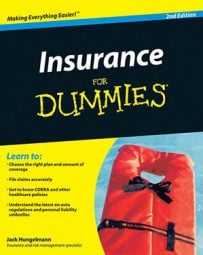Life insurance is meant to replace your income if you die prematurely. If you’re married, in a committed relationship, or have children who depend on your income, you need life insurance. If you have a stay-at-home spouse or partner caring for your home and children, you would be faced with some very substantial costs to replace those services if he or she dies. Here are the primary types of life insurance to choose from; each product has its appropriate uses:
Term Life Insurance
Like home and auto insurance, term life insurance is pure insurance in that it pays off only if you make a claim. The cost of the insurance can go up every year or remain level for a specific number of years. You can lose your insurance coverage if the term expires and the policy isn’t guaranteed renewable or if you elect not to renew. However, term insurance is the cheapest form of life insurance, and the only appropriate type of life insurance for most people.
Twenty-year level term coverage is generally an excellent option for families with young children because the insurance will be there to support the surviving family at least until the kids are grown. Here are some options to consider:
Level premium insurance, which is extremely cost-effective, guarantees a set premium amount for a set number of years. Choose level premium term insurance with a guaranteed level premium for the number of years that you anticipate needing the coverage.
A guaranteed renewable rider is a very attractive feature available with many term insurance policies. It ensures that you'll be able to retain a term policy at the end of its initial term — if you still need the insurance — simply by paying the premiums in effect at that time. You don’t have to reapply or provide evidence of insurability.
If you need coverage for only five to ten years, you may want to consider Annual Renewable Term (ART) life insurance because it tends to be less expensive for the first five or six years of the policy, but every year thereafter, the premiums continue to increase. It makes no sense, though, to buy this coverage unless you won't need it very long. In every other situation where term insurance would be appropriate, go with the level premium term insurance.
Permanent Life Insurance
With permanent life insurance, the cost is substantially higher in the first several years of your coverage. However, the cost can’t go up. The initial premium rate is as bad as it’ll ever get, and the insurance company can’t deny you benefits as long as you pay your premiums on time. So, if you need life insurance coverage forever — for example, if you need cash available for your heirs to pay estate or inheritance taxes upon your death — you’re a good candidate for permanent life insurance. Permanent insurance comes in two primary flavors:
Universal: You may possibly need a lot of life insurance now and well into your retirement years. If this is the case, get universal life insurance for at least a portion of your life insurance needs.
Whole: If you need coverage for your entire life, no matter how long you live, whole life insurance might be the right option.
Insurance agents make a lot more money selling universal life, variable universal life, and whole life insurance than they do selling term insurance. Keep this inherent conflict of interest in mind whenever you consider the recommendations of an insurance agent.

